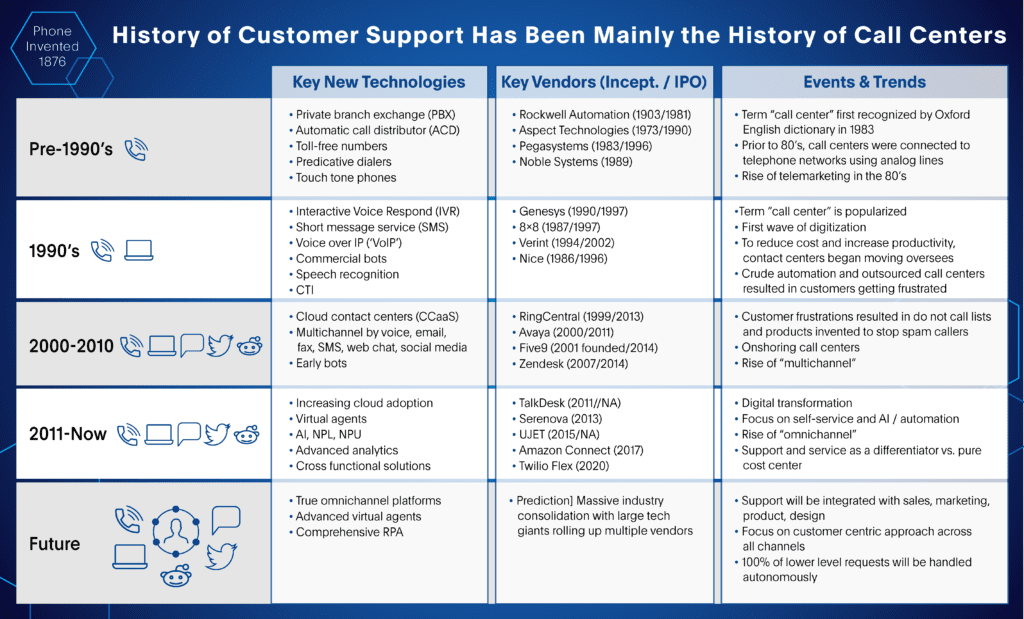Canceled flights, missed food deliveries and delayed packages, oh my! The flood of customer inquiries in the past few months has stress-tested even the most advanced customer support organizations. According to a recent Intercom survey, 47 percent of customer support teams reported a 51 percent increase in inbound service requests since the beginning of the COVID-19 pandemic starting in mid-March. The same report shows that the complexity of these interactions has also grown as customers increasingly turn to the mobile web, apps, social networks and other channels to engage with brands.
To adapt to these challenging conditions and tackle these new problems head-on, customer support leaders are turning to next-gen technologies. Below is an examination of how the healthcare crisis has accelerated the shift towards innovative customer service solutions and a spotlight on key areas of focus for the future of customer support.
Reducing load during peak phone volumes
The primary goals for self-service are to enable customers to quickly and easily resolve their issues and to reduce the number of inbound calls into the customer contact center. For many companies, self-service can mean a static FAQ page, but more innovative organizations are adopting advanced solutions such as knowledge management systems to serve up personalized and contextualized responses. Knowledge management systems store and retrieve real-time information related to customer questions and issues. Over time, these systems learn common patterns and quickly suggest solutions. Self-serve platforms like Zoomin are also able to tap into other repositories of product information including Pendo or GitLab for an even more personalized self-service experience.
While customers often turn to phone calls as their primary support modality for urgent or complex requests, calls are one-to-one interactions and therefore, not easily scalable for a company. When service inquiries dramatically spike as they have been during COVID-19, a logjam situation occurs. To help customers in need fast, companies are adopting a deflection strategy whereby they encourage customers to connect with them across other channels including conversational AI, texting, in-app messaging and online or expert communities.
- Conversational AI bots and virtual agents offered by companies like Acquire and Replicant resolve basic questions without any agent interaction.
- Texting and in-app chat offered by companies like UJET, a recent Sapphire Ventures investment, provide quick response times compared to email, which often may take a full business day or more to process. Agents can also handle more than one interaction at a time.
- Online communities and experts provided by companies such as Directly allow customers to get support from a wider network. For example, Instacart recently launched “Shop Talk” which is a virtual community for shoppers to assist each other on service issues, and Airbnb leverages members of its “superhost” network.
Intelligent self-service, triage and automation tools are key to better volume management, increased agent productivity and enhanced customer experience.
AI-based tools that boost agent productivity
In addition to customer service challenges, practically overnight, COVID-19 forced companies to navigate their call center workforce becoming fully remote, which has led to declining productivity and agent frustrations.
Startups leveraging voice AI to understand calls and extract key insights are useful in helping prepare agents and providing guidance during a live customer session. These tools can also give managers insight into overall agent productivity, as well as help train and onboard new agents, which can be incredibly challenging in a remote environment. Here are a couple of companies that are leveraging voice AI to boost agent productivity:
- Observe.AI uses voice AI and real-time sentiment analysis to automatically analyze 100 percent of calls for quality assurance, compliance monitoring and training for customers like Root Insurance.
- Cresta is an agent assist tool that can reduce time per session. In a 2017 study, IBM found that agents spent 75 percent of a six-minute customer service call doing manual research with only 25 percent of calls being valuable to customers.
It’s easy to understand why there has been so much attention on AI and automation in customer support after reviewing how much money is spent to help resolve customer issues. Customer support is incredibly labor-intensive. Five9 finds that today, roughly 90 percent of customer support spend is on labor and only 10 percent is spent on software. To address this level of manual work, a major wave of technological innovation in customer support occurs roughly every decade. Changes in customer support technology have affected the types of roles and skills required for frontline support agents.

In the future, advanced AI technologies will automate the majority of basic questions and requests, and the role of agents will evolve into specialized and often technical customer experience experts.
Cloud tech provides flexibility and scale for next-gen customer support
Technological frictions arising from a remote work environment are further driving the shift to the cloud. The migration to the cloud is still in its early innings with about 15 percent industry penetration in customer support, according to Five9. Part of the reason why cloud penetration in the call center space has lagged behind other enterprise software categories like CRM, HCM, and ITSM is due to the complexity of all the underlying technologies needed to operate a call center in the cloud. We expect COVID-19 to accelerate cloud adoption ahead of the average eight to ten year technology refresh cycle seen in the industry.
While customer support has traditionally been thought of as a call center, the pandemic has highlighted the importance of this business function within the broader umbrella of customer experience. By handling a customer issue during a time of great urgency and duress with grace and efficiency, a company can gain a lifelong customer, while a clumsy fumble can create significant and permanent damage to a brand. As brands race to find optimal ways to serve their customers and deliver truly differentiated experiences, customer support leaders will continue to adopt technologies that not only empower their agents to be successful and provide key customer service insights, but also work seamlessly with sales, marketing and product teams.




